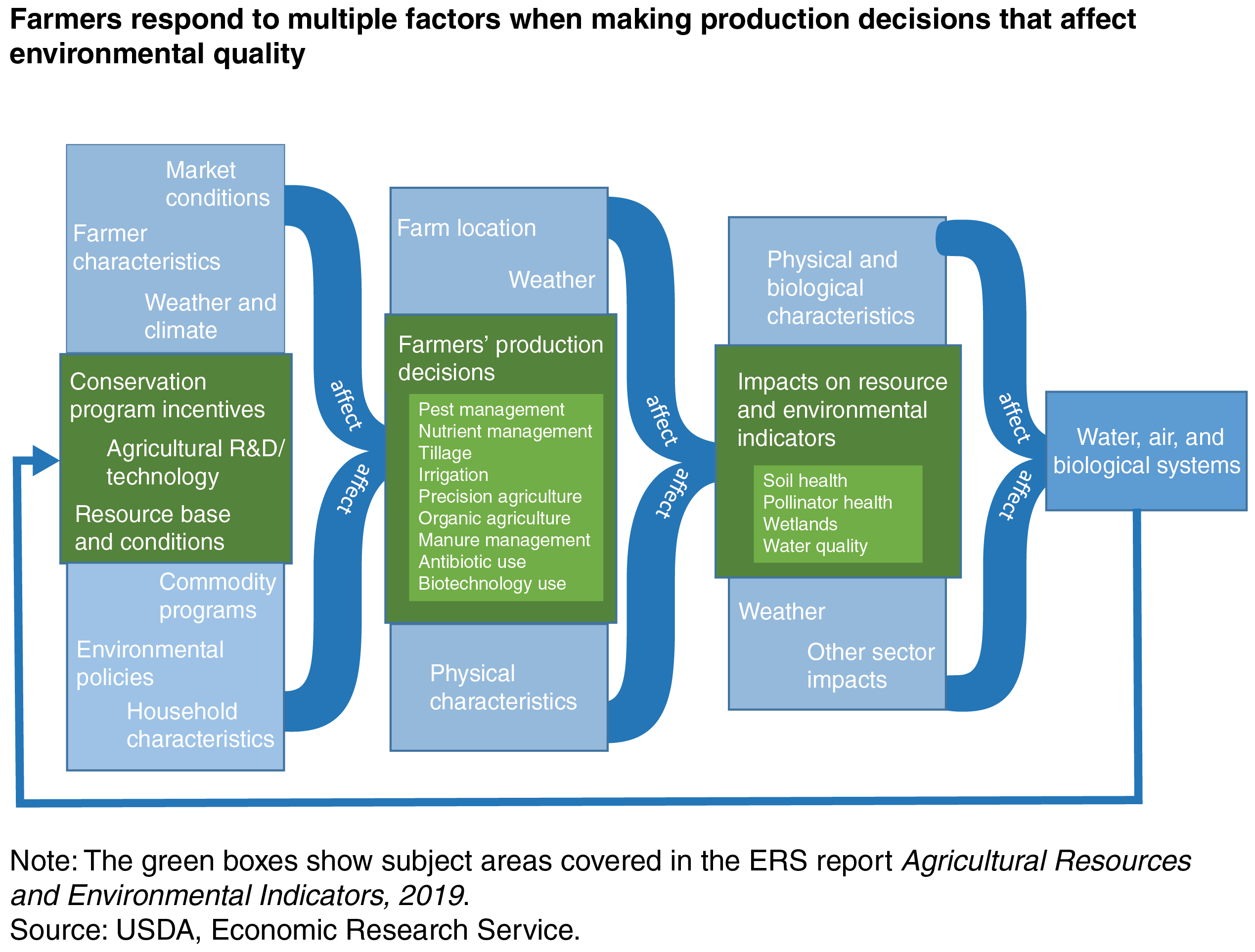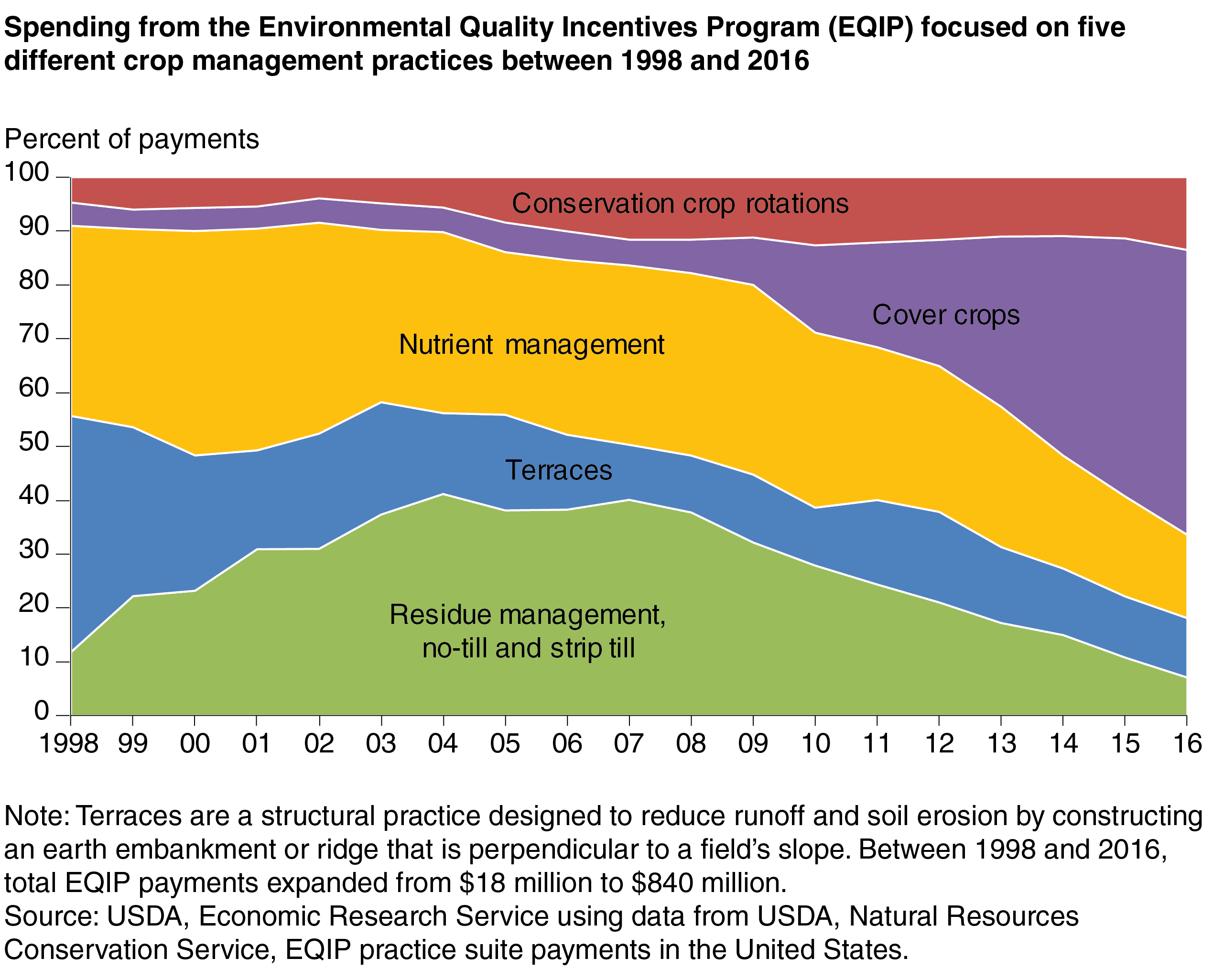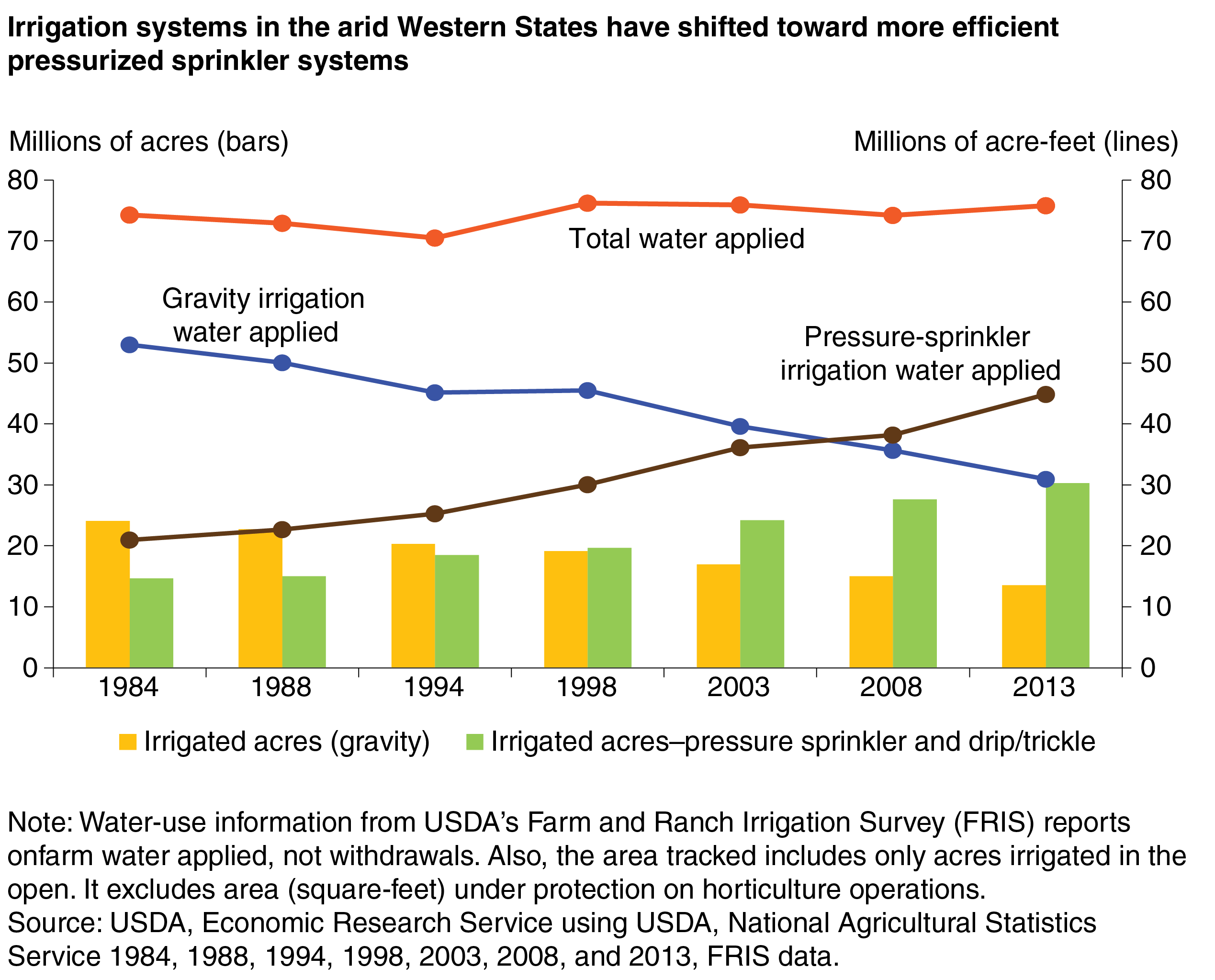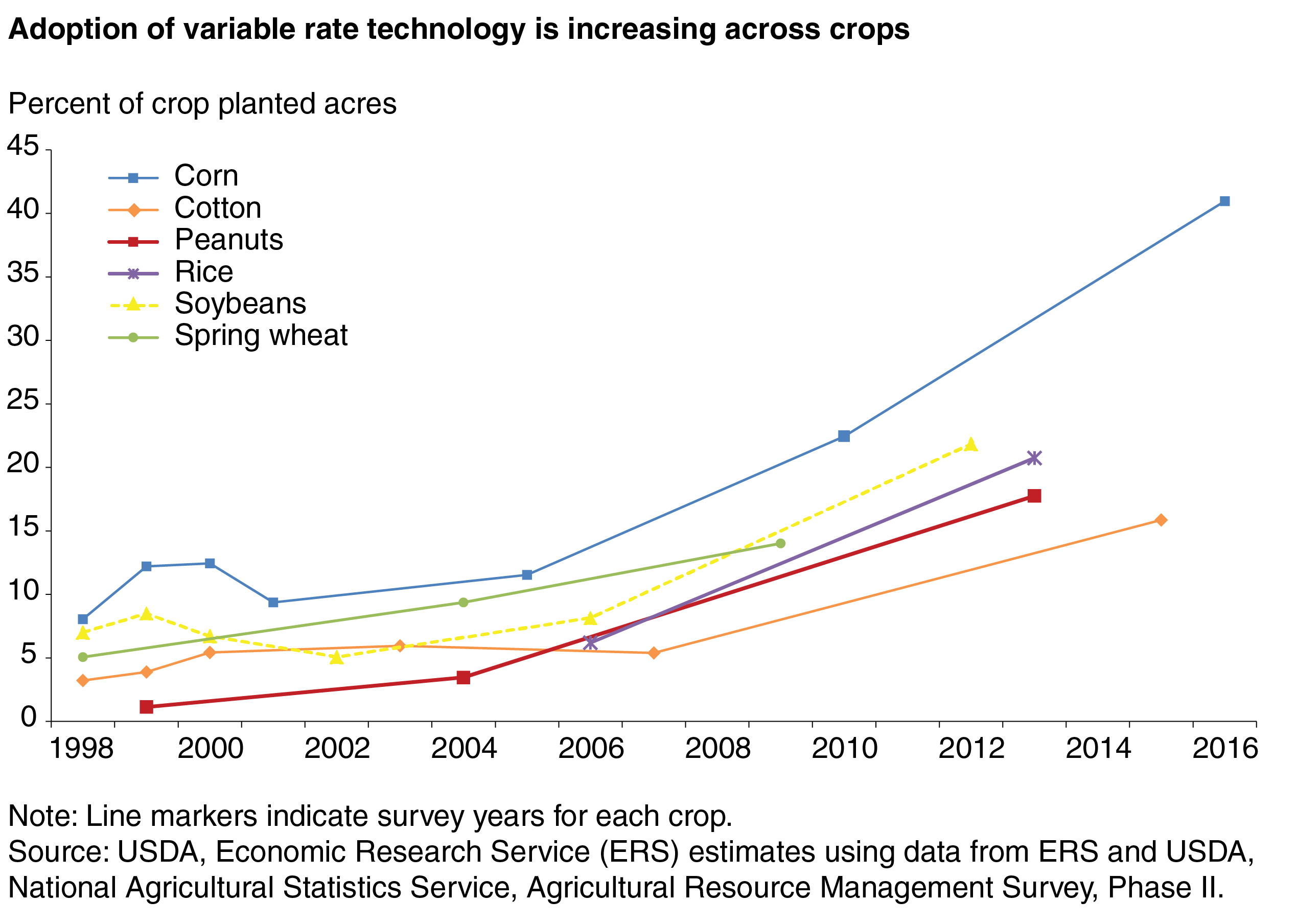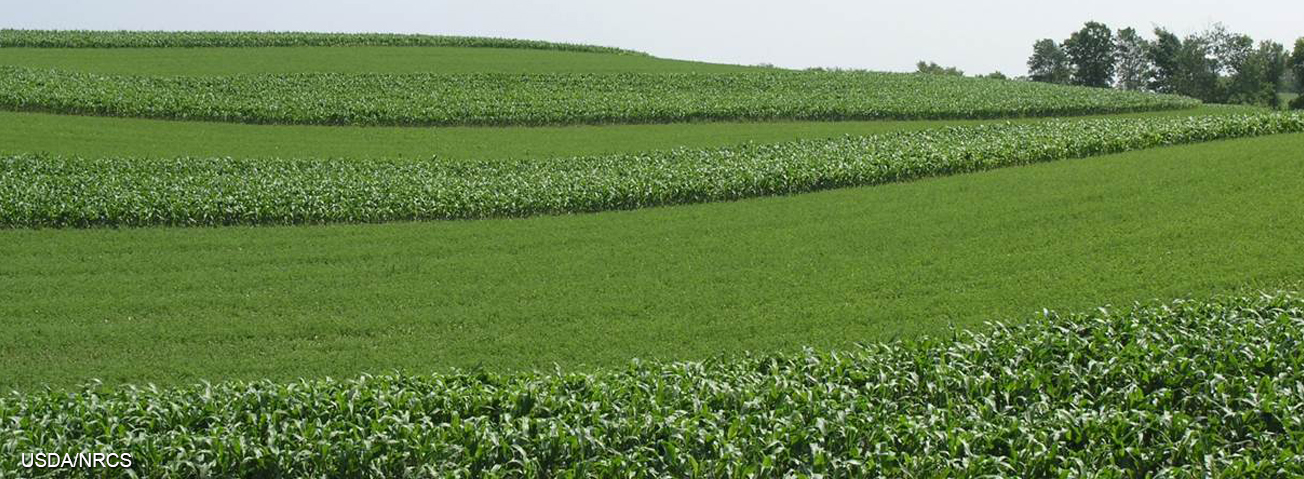
Conservation Trends in Agriculture Reflect Policy, Technology, and Other Factors
- by Elizabeth Marshall, Kelly B. Maguire, Daniel Hellerstein and David Schimmelpfennig
- 8/12/2019
Highlights
- Concerns about agriculture’s impact on the environment encompass issues related to soil health and productivity, water quality and quantity, and nutrient and pesticide use. Those impacts are mediated by a wide range of factors influencing farmer decision-making, including policy incentives for conservation and availability of technology options for input and field management.
- The Environmental Quality Incentives Programs (EQIP) awards cost-share funding to farmers who voluntarily adopt soil conservation practices. The top five conservation practices awarded funding through EQIP since 1998 have been: cover crops, conservation tillage/residue management, conservation crop rotation, terraces, and nutrient management. Between 1982 and 2012, soil erosion declined on cultivated cropland by 45 percent, in part due to expanded adoption of soil conservation practices.
- Variable rate technologies (VRT) have the potential to reduce both input costs and off-field environmental impacts by allowing farmers to customize their field management decisions by the foot rather than by the field. By 2016, 40 percent of planted corn acreage was managed using VRT equipment.
Every season farmers face a suite of production and conservation decisions, including crop and variety selection, fertilizer use, conservation strategies, and timing and intensity of tillage and irrigation. These decisions are informed by factors such as agricultural policy and technology availability. Production choices can impact the health of the environment by affecting soil erosion, nutrient pollution, and water availability and quality. In turn, agricultural productivity is dependent upon the health of the resource base, which is broadly defined to include soil, water, and air quality, as well as related factors such as pollinator health and climate. The recent ERS publication Agricultural Resources and Environmental Indicators, 2019 explores trends in factors that influence farmer decisions, such as agricultural policy and technology availability, as well as the resulting impacts on resource and environmental quality measures.
Government policies influence farmer and rancher decision-making, impacting the relationships between agriculture, resource use, and the environment. For example, USDA conservation programs provide nearly $6 billion annually for financial and technical assistance to support the adoption of conservation practices on U.S. farms. The USDA conservation effort relies mainly on voluntary incentive programs. While the largest single conservation program (in terms of budget) is the Conservation Reserve Program (CRP), which provides funding for retirement of environmentally sensitive land, the largest share of conservation funding goes toward incentivizing conservation practices on lands that remain in production—or “working lands.” The Environmental Quality Incentives Program (EQIP) is one such program, which provides financial assistance to farmers who adopt or install conservation practices on land in agricultural production. The top five crop management practices (in terms of expenditures) awarded support through EQIP have been conservation crop rotation, cover crops, nutrient management, terraces, and conservation tillage (residue management).
Conservation tillage is an example of a practice incentivized directly through working land conservation programs like EQIP, as well as indirectly through “conservation compliance” requirements. Conservation compliance requires that operators who farm highly erodible cropland adopt conservation tillage to maintain eligibility for Federal agricultural programs. Reducing or eliminating tillage minimizes soil disturbance, which reduces soil erosion, conserves soil moisture, and promotes better soil health. “No-till” involves planting directly within the residue of the previous crop, while “mulch till” lightly disturbs the soil but preserves much of the previous crop residue. Between 2004 and 2017, wheat producers increased the share of planted acres under conservation tillage from 37 percent to 67 percent, and more modest increases were observed for corn, soybeans, and cotton.
As farmers have adopted soil health and conservation practices like conservation tillage, they have helped reduce soil erosion on the Nation’s working lands. Between 1982 and 2012, the USDA Natural Resources Conservation Service’s National Resources Inventory (NRI) shows erosion on cultivated cropland (due to water and wind) declined by 45 percent, from 2.9 billion tons in 1982 to 1.6 billion tons in 2012. Though part of this decline is due to less land being cropped over time, a large portion is due to changes in farm management practices.
Changing conservation incentives through Federal programs such as the CRP and EQIP interact with the evolving availability of technology to further influence farmers' production decisions, resource use, and environmental quality. Conservation programs, together with the development of more efficient irrigation application systems, have driven an increase in agricultural water-use efficiency, for instance. The shift from gravity-flow irrigation to more efficient pressurized sprinkler systems (including drip/trickle) has been particularly significant. In the 17 Western States, irrigation water applied using gravity systems declined from 71 percent of total applied water in 1984 to 41 percent in 2013, with a corresponding increase in water applied through pressurized sprinkler systems. Total applied water remained fairly constant over that period, reflecting other dynamic factors influencing regional agricultural water demand—including increases in irrigated area, changes in cropping patterns, rising crop yields, and shifts in consumptive water use.
The development of precision agriculture technologies has also altered the farm management decisions available to farmers, and the environmental implications of those decisions. For example, variable rate technologies (VRT) use localized field crop condition information to customize the application of inputs such as seeds, fertilizers, and pesticides. VRT allow farmers to manage their inputs foot by foot, rather than field by field, and to use only prescribed amounts of inputs, which lowers producer’s costs and also reduces the off-field impacts of those inputs. By 2016, 40 percent of planted corn acreage was managed using VRT equipment.
The ERS report Agricultural Resources and Environmental Indicators, 2019 provides a comprehensive source of data and analysis on the factors that affect resource use and quality in American agriculture. The report explores trends in a wide range of elements including public policies, farm structure and economic conditions, farming and conservation practices, productivity and technological change, resource use, commercial input use (including energy, nutrients, pesticides, and antibiotics) and environmental impact indicators. This information is essential to inform public and private decision-making on how best to manage agricultural inputs and production, and their interactions with natural resources, to preserve the health of the resource base and the productivity of the agricultural sector.
This article is drawn from:
- Hellerstein, D., Vilorio, D., Ribaudo, M., Aillery, M., Bigelow, D., Bowman, M., Burns, C., Claassen, R., Crane-Droesch, A., Fooks, J., Greene, C., Hansen, L., Heisey, P., Hitaj, C., Hoppe, R.A., Key, N., Lynch, L., Malcolm, S., McBride, W.D., Mosheim, R., Nehring, R., Schaible, G., Schimmelpfennig, D., Smith, D., Sneeringer, S., Wade, T., Wallander, S., Wang, S.L. & Wechsler, S.J. (2019). Agricultural Resources and Environmental Indicators, 2019. U.S. Department of Agriculture, Economic Research Service. EIB-208.
You may also like:
- Claassen, R., Bowman, M., McFadden, J., Smith, D. & Wallander, S. (2018). Tillage Intensity and Conservation Cropping in the United States. U.S. Department of Agriculture, Economic Research Service. EIB-197.
- Marshall, E., Aillery, M., Ribaudo, M., Key, N., Sneeringer, S., Hansen, L., Malcolm, S. & Riddle, A. (2018). Reducing Nutrient Losses From Cropland in the Mississippi/Atchafalaya River Basin: Cost Efficiency and Regional Distribution. U.S. Department of Agriculture, Economic Research Service. ERR-258.
- Wallander, S., Claassen, R., Hill, A. & Fooks, J.R. (2019). Working Lands Conservation Contract Modifications: Patterns in Dropped Practices. U.S. Department of Agriculture, Economic Research Service. ERR-262.


